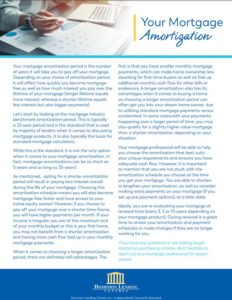| Monthly Payments: A monthly payment is simply a single large payment, paid once per month; this is the default that sets your amortization. A 25-year mortgage, paid monthly, will take 25 years to pay off but includes the added burden of one larger payment coming from one employment pay period. With this payment frequency, you make 12 payments per year.
Example: $750k mortgage, 3-year fixed rate, 5.34%, 30-year amortization you would have a monthly payment of $4,156.19. No term savings; no amortization savings.
Bi-Weekly Payments: A bi-weekly mortgage payment is a total of 26 payments per year, calculated by multiplying your monthly mortgage payment by 12 months and divided by the 26 pay periods.
Example: $750k mortgage, 3-year fixed rate, 5.34%, 30-year amortization you would have a bi-weekly payment of $1,915.98 with term savings of $177 and total amortization savings of $1,769.
Accelerated Bi-Weekly Payments: An accelerated bi-weekly mortgage payment is also 26 payments per year, but the payment amount is higher than a regular bi-weekly payment frequency. Opting for an accelerated bi-weekly payment will not only pay your mortgage off quicker, but it’s guaranteed to save you a significant amount of money over the term of your mortgage. This frequency also allows the mortgage payment to be split up into smaller payments vs a single, larger payment per month. This is especially ideal for households who get paid every two weeks as the reduction in cash flow is more on track with incoming income.
Example: $750k mortgage, 3-year fixed rate, 5.34%, 30-year amortization you would have accelerated bi-weekly payments of $2,078.10 with term savings of $1,217 and total amortization savings of $145,184. Plus, you would save 4 years, 12 months of payments by reducing scheduled amortization.
Weekly Payments: Similar to monthly payments, your weekly mortgage payment frequency is calculated by multiplying your monthly mortgage payment by 12 months and dividing by 52 weeks in a year. In this case, you would make 52 payments a year on your mortgage.
Example: $750k mortgage, 3-year fixed rate, 5.34%, 30-year amortization you would have weekly payments of $957.50 with term savings of $253 and total amortization savings of $2,526. You can move to accelerated weekly payments to save even more!
Prepayment Privileges: In addition to fine-tuning your payment schedule, most mortgage products include prepayment privileges that enable you to pay up to 20% of the principal (the true value of your mortgage minus the interest payments) per calendar year. This can help reduce your amortization period (the length of your mortgage).
By exercising your prepayment privileges, you can take time off your mortgage. For instance:
- Extra $50 bi-weekly is $32,883 total savings and an additional 1 year, 2 months time saved
- Extra $100 bi-weekly is $62,100 in total savings and an additional 2 years, 3 months time saved on your mortgage
- Extra $200 bi-weekly is $111,850 in total savings and an additional 4 years, 1 month of time saved on your mortgage.
Understanding the different payment frequencies can be key in managing your monthly cash flow. If you’re struggling to meet a large payment, breaking it up can be effective; while the same can be true of the opposite. Individuals struggling to make a weekly or bi-weekly payment, may benefit from one monthly sum where they have time to collect the funds.
Consider getting in touch with me today to determine what payment frequency is best for you OR you can download my app and calculate them for yourself! |



